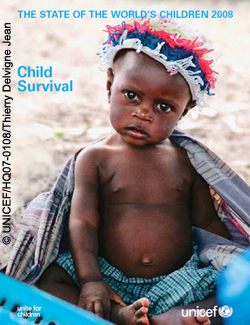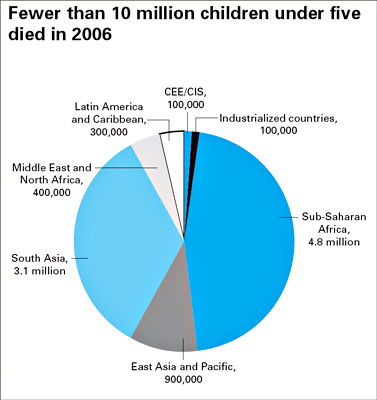Center for Communications, Health and the Environment

But, Major Challenges Lie Ahead
UNICEF Reports Progress, Cites Challenges to Curtailing Global Child Mortality
In 1960, roughly 20 million newborns did not live to see their fifth birthday; by 2006, the annual number of child deaths globally fell below 10 million, to 9.7 million, for the first time since records began.
This is significant and encouraging news, yet every day on average, more than 26,000 children under the age of five still die around the world, mostly from preventable causes. Nearly all of them live in the developing world or, more precisely, in 60 developing countries. More than one-third of these children die during the first month of life, usually at home and without access to essential health services and basic commodities that might save their lives.
Born of large-scale concern, UNICEF’s landmark report, The State of the World’s Children 2008, examines the status of child survival and primary health care for children across the globe, with a strong emphasis on trends in child mortality. This seminal report by the United Nations Children’s Fund (UNICEF) outlines the results of long-term partnerships developed in response to the child survival revolution, reviews the experiences and approaches to child survival and health of recent decades, and appraises the lessons from failures and successes in child survival over the past century.
The centerpiece of the report examines several of the most promising approaches – community partnerships, the continuum of care framework and health-system strengthening for outcomes – to reach those mothers, newborns and children who are currently excluded from essential interventions. By highlighting examples from countries and districts where these have been successful and exploring the main challenges to their expansion, this report offers practical ways to jump-start progress. [See Full Lead Article]
Q&A With Dr. Peter Salama
Dr. Peter Salama is Chief of Health, Associate Director, Programme Division, UNICEF, New York, N.Y.
1. UNICEF’s State of the World’s Children 2008 report states that the latest data (i.e., from 2006) show a dramatic reduction in under-five annual global mortality from almost 13 million in 1990 to 9.7 million. What causes of childhood mortality have shown the greatest reductions and which the least? 
In 2006, for the first time in recent history, the number of children dying before their fifth birthday fell below 10 million – an important milestone in child survival. Around 1960, an estimated 20 million children under age five were dying every year, highlighting an important long-term decline in the global number of child deaths.
While we know the overall estimates of child mortality, the cause-specific information is not that often actualized, and we are continuously working with different groups and institutions to refine this information. We do know from the recent data that coverage of many key child survival interventions has significantly increased, with rises in some basic practices and services, including vitamin A supplementation, the use of insecticide-treated nets to prevent malaria, immunization, and early and exclusive breast-feeding, improving the health of children. Many of the statistics are encouraging. For example:
- More than four times as many children received the recommended two doses of vitamin A in 2005 compared to 1999.
- All countries with trend data in sub-Saharan Africa made progress in expanding coverage of insecticide-treated nets, with 16 of these 20 countries at least tripling coverage since 2000.
- In the 47 countries where 95 per cent of measles deaths occur, measles immunization coverage increased from 57 per cent in 1990 to 68 per cent in 2006.
- Rates of exclusive breastfeeding have significantly improved in 16 countries of sub-Saharan Africa over the past decade, with seven of these countries making gains of 20 percentage points or more.
- Progress has also been made in expanding coverage of antenatal care and skilled care at delivery – with every region showing improvements during the past decade.
- Between 1990 and 2004, more than 1.2 billion people gained access to improved sources of drinking water, and the world is on track to achieve the UN target for safe water.
These new figures show that progress is possible if we act with renewed urgency to scale up interventions that have proven effective. [See Full Q&A with Dr. Salama]

Dr. Sushma Palmer, Program Director
Valeska Stupak, Editorial & Design Consultant
Shiraz Mahyera, Systems Manager
Rohit Tote, Website Consultant